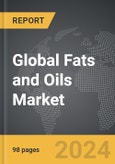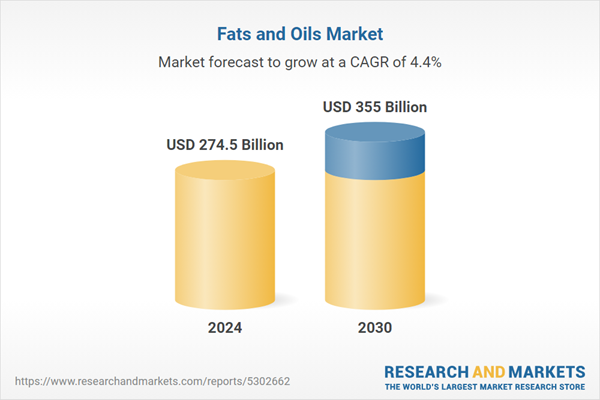Global Fats and Oils Market - Key Trends & Drivers Summarized
What Is Driving the Demand for Fats and Oils Worldwide?
The global demand for fats and oils is being driven by the expanding food and beverage industry, rising urbanization, and increased consumer awareness of dietary fats' role in health. Fats and oils are essential components in food production, used for flavor, texture, and as cooking mediums in diverse cuisines worldwide. As urban populations grow, so does the demand for processed and packaged foods, which often contain various types of fats and oils to enhance flavor and shelf life. Moreover, a rising middle-class population with greater disposable income is consuming more diverse diets, which fuels demand for specialized oils, including olive, avocado, and coconut oils, as well as standard cooking oils like palm, soybean, and sunflower oil. With consumer interest in culinary diversity, food companies are responding by incorporating a variety of oils into their products, expanding market growth.The global market is also witnessing a rising demand for edible oils with specific health benefits. Consumers are increasingly seeking oils rich in monounsaturated and polyunsaturated fats, which are perceived as healthier than saturated fats. Olive oil, in particular, has gained prominence due to its association with the Mediterranean diet, which has been linked to numerous health benefits. Oils high in omega-3 and omega-6 fatty acids are also in demand, especially among health-conscious individuals and those looking to prevent lifestyle-related illnesses. As awareness about the benefits of plant-based diets and heart-healthy fats grows, so does the interest in oils that cater to these dietary preferences, driving a shift in consumer purchasing patterns and boosting market growth.
How Are Technological Advancements Transforming the Fats and Oils Market?
Technological advancements are revolutionizing the fats and oils market by improving extraction, processing, and refinement methods. Innovations in cold-pressing and solvent extraction techniques have allowed manufacturers to produce higher-quality oils that retain more of their natural nutrients and flavors. For instance, cold-pressed oils, such as extra-virgin olive oil, coconut oil, and almond oil, are now preferred by consumers for their minimal processing and retained nutritional value. Enhanced refining processes have also enabled the removal of undesirable compounds in certain oils, such as trans fats, which has made refined oils healthier and more attractive to consumers. Additionally, advancements in genetic modification and crop cultivation techniques have led to the development of high-oleic oils, which contain healthier fat profiles, extending shelf life and improving stability for cooking and frying applications.Furthermore, technology is helping manufacturers meet the rising demand for specialty and sustainable oils. For instance, precision fermentation and lab-grown oils are emerging as innovative solutions for plant-based and environmentally-conscious markets, providing alternatives to traditional oils like palm oil, which have faced scrutiny over deforestation and habitat destruction. In addition, automation and AI-driven quality control systems allow for efficient production and quality assurance, reducing waste and ensuring consistent oil quality. With these technological advancements, the fats and oils industry is not only improving the health and safety profiles of its products but also enhancing its capacity to meet the sustainability expectations of modern consumers.
What Role Do Health Trends and Dietary Preferences Play in Shaping the Fats and Oils Market?
Health trends and evolving dietary preferences are significantly influencing the fats and oils market, with consumers increasingly favoring products that align with wellness and lifestyle goals. The rise of diets such as keto, paleo, and Mediterranean has popularized specific fats and oils, such as coconut oil, olive oil, and clarified butter (ghee), which are in high demand for their perceived health benefits. These dietary trends often emphasize the role of healthy fats in promoting satiety, brain function, and heart health, making them attractive to a health-conscious market. As a result, fats and oils rich in medium-chain triglycerides (MCTs), monounsaturated fats, and omega-3 fatty acids are growing in popularity, as they align with dietary needs for high-fat, low-carb diets like keto. These dietary preferences have driven a surge in demand for oils with beneficial fat profiles, catering to consumers aiming to manage weight, energy levels, and overall health. In addition, the plant-based movement has introduced a new wave of consumer interest in oils that complement vegan and vegetarian diets. Oils derived from sources like flaxseed, chia, and hemp are in demand for their omega-3 content and compatibility with plant-based nutrition. The trend toward natural, organic, and non-GMO products has also influenced purchasing patterns, as consumers seek clean-label oils with minimal processing and no artificial additives. To cater to these preferences, manufacturers are increasingly labeling products as organic, cold-pressed, and free of hydrogenated fats, appealing to a health-conscious consumer base. This shift toward transparency and health-centric labeling is redefining the fats and oils market, as companies align product development with emerging dietary and wellness trends.What Factors Are Driving Growth in the Fats and Oils Market?
The growth in the global fats and oils market is fueled by a blend of culinary diversity, technological progress, health-conscious consumer preferences, and sustainability initiatives. As demand for processed and prepared foods rises globally, so does the need for various fats and oils used in manufacturing, cooking, and enhancing flavor and texture. Technological innovations in extraction and refinement, along with sustainable sourcing practices, have made it possible for manufacturers to offer high-quality products that cater to modern health and environmental expectations. As a result, oils rich in unsaturated fats, such as olive, sunflower, and avocado oil, are gaining popularity, with consumers drawn to their heart-health benefits. Additionally, sustainability concerns are driving a shift toward more eco-friendly options, with brands investing in ethically sourced oils and supporting practices that minimize environmental impact. This is particularly evident in the palm oil industry, where sustainable palm oil certification and alternative oil sources are gaining traction in response to consumer concerns. The rise in plant-based diets is also increasing demand for specialty oils that align with vegan and vegetarian preferences, while dietary trends like keto and paleo boost interest in nutrient-dense oils and fats. The combination of these factors is propelling the fats and oils market forward, allowing it to adapt and thrive amidst changing consumer values and technological advancements.Report Scope
The report analyzes the Fats and Oils market, presented in terms of market value (US$ Thousand). The analysis covers the key segments and geographic regions outlined below.- Segments: Form (Liquid, Solid); Product Segment (Oils, Fats); End-Use (Food, Industrial).
- Geographic Regions/Countries:World; United States; Canada; Japan; China; Europe (France; Germany; Italy; United Kingdom; Spain; Russia; and Rest of Europe); Asia-Pacific (Australia; India; South Korea; and Rest of Asia-Pacific); Latin America (Argentina; Brazil; Mexico; and Rest of Latin America); Middle East (Iran; Israel; Saudi Arabia; United Arab Emirates; and Rest of Middle East); and Africa.
Key Insights:
- Market Growth: Understand the significant growth trajectory of the Liquid Form segment, which is expected to reach US$239.1 Billion by 2030 with a CAGR of a 4.7%. The Solid Form segment is also set to grow at 3.8% CAGR over the analysis period.
- Regional Analysis: Gain insights into the U.S. market, valued at $72.1 Billion in 2024, and China, forecasted to grow at an impressive 6.9% CAGR to reach $76.9 Billion by 2030. Discover growth trends in other key regions, including Japan, Canada, Germany, and the Asia-Pacific.
Why You Should Buy This Report:
- Detailed Market Analysis: Access a thorough analysis of the Global Fats and Oils Market, covering all major geographic regions and market segments.
- Competitive Insights: Get an overview of the competitive landscape, including the market presence of major players across different geographies.
- Future Trends and Drivers: Understand the key trends and drivers shaping the future of the Global Fats and Oils Market.
- Actionable Insights: Benefit from actionable insights that can help you identify new revenue opportunities and make strategic business decisions.
Key Questions Answered:
- How is the Global Fats and Oils Market expected to evolve by 2030?
- What are the main drivers and restraints affecting the market?
- Which market segments will grow the most over the forecast period?
- How will market shares for different regions and segments change by 2030?
- Who are the leading players in the market, and what are their prospects?
Report Features:
- Comprehensive Market Data: Independent analysis of annual sales and market forecasts in US$ Million from 2024 to 2030.
- In-Depth Regional Analysis: Detailed insights into key markets, including the U.S., China, Japan, Canada, Europe, Asia-Pacific, Latin America, Middle East, and Africa.
- Company Profiles: Coverage of players such as Ajinomoto Co., Inc., Archer Daniels Midland Company, Associated British Foods PLC (ABF), Bunge Limited, Cargill, Incorporated and more.
- Complimentary Updates: Receive free report updates for one year to keep you informed of the latest market developments.
Some of the 52 companies featured in this Fats and Oils market report include:
- Ajinomoto Co., Inc.
- Archer Daniels Midland Company
- Associated British Foods PLC (ABF)
- Bunge Limited
- Cargill, Incorporated
- Conagra Foods, Inc.
- Fuji Oil Holding Inc.
- International Foodstuff Company Holdings Limited (IFFCO)
- Olam International
- Unilever PLC
- United Plantations Berhad
- Wilmar International Limited
This edition integrates the latest global trade and economic shifts into comprehensive market analysis. Key updates include:
- Tariff and Trade Impact: Insights into global tariff negotiations across 180+ countries, with analysis of supply chain turbulence, sourcing disruptions, and geographic realignment. Special focus on 2025 as a pivotal year for trade tensions, including updated perspectives on the Trump-era tariffs.
- Adjusted Forecasts and Analytics: Revised global and regional market forecasts through 2030, incorporating tariff effects, economic uncertainty, and structural changes in globalization. Includes historical analysis from 2015 to 2023.
- Strategic Market Dynamics: Evaluation of revised market prospects, regional outlooks, and key economic indicators such as population and urbanization trends.
- Innovation & Technology Trends: Latest developments in product and process innovation, emerging technologies, and key industry drivers shaping the competitive landscape.
- Competitive Intelligence: Updated global market share estimates for 2025, competitive positioning of major players (Strong/Active/Niche/Trivial), and refined focus on leading global brands and core players.
- Expert Insight & Commentary: Strategic analysis from economists, trade experts, and domain specialists to contextualize market shifts and identify emerging opportunities.
Table of Contents
Companies Mentioned (Partial List)
A selection of companies mentioned in this report includes, but is not limited to:
- Ajinomoto Co., Inc.
- Archer Daniels Midland Company
- Associated British Foods PLC (ABF)
- Bunge Limited
- Cargill, Incorporated
- Conagra Foods, Inc.
- Fuji Oil Holding Inc.
- International Foodstuff Company Holdings Limited (IFFCO)
- Olam International
- Unilever PLC
- United Plantations Berhad
- Wilmar International Limited
Table Information
| Report Attribute | Details |
|---|---|
| No. of Pages | 376 |
| Published | December 2025 |
| Forecast Period | 2024 - 2030 |
| Estimated Market Value ( USD | $ 274.5 Billion |
| Forecasted Market Value ( USD | $ 355 Billion |
| Compound Annual Growth Rate | 4.4% |
| Regions Covered | Global |









